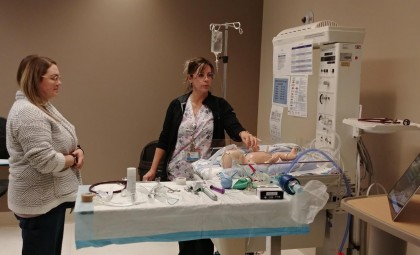An Algorithm to Ensure the Best Start to Life

A successful reduction of newborn CPAP rates at Hôpital Montfort
When asked what makes France Morin proud of her work at Hôpital Montfort, she says without hesitation, “The team is very collaborative in our unit and when you have that collaboration… that’s when the results come.”
Morin, one of the Clinical Managers of the Family Birthing Centre at Montfort, was speaking specifically about the impressive results they’ve seen around the goal to reduce Continuous Positive Airway Pressure (CPAP) rates for newborns at the organization.
Prior to this initiative, BORN Ontario data showed that CPAP rates for newborns born at Hôpital Montfort’s Family Birthing Center were 3.5 times higher (13.4 per cent) compared to other level 2a Family Birthing Units in Ontario (3.8 per cent) (BORN Ontario, 2018-2019).
The Montfort team acknowledged that their CPAP rates were too high and that they had to rectify their current practices in order to prevent adverse neonatal outcomes associated with complications of CPAP, which include pneumothorax, decreased cardiac output, gastric distension, feeding intolerance, skin irritation, etc. (Claassen, C.C., Strand, M. L., 2019).
In addition to being exposed to medical complications, these babies are being separated from their parents at birth which has been shown in the literature to negatively affect bonding and breastfeeding success (Safari, K., Saeed, A. A., Hasan, S. S., Moghaddam, L., 2018). These babies often require an admission to the Special Care Nursery, resulting in less skin-to–skin contact with parents, more mother-infant dyad separation and more interventions.
“We knew we had some work to do to decrease our CPAP rates,” Morin said. “So, our plan was to review our current practices and policies, and provide training to healthcare professionals (pediatricians, nurses and respiratory therapists) in order to improve their knowledge, skills or abilities.”
At the same time, work was underway on developing a CPAP algorithm to guide all healthcare professionals in the delivery room in order to reduce the rates of CPAP and increase immediate skin-to-skin and rooming-in rates.
During the fall, virtual in-service education regarding the CPAP algorithm was provided, combined with interdisciplinary workshops for respiratory therapists and nurses.
“Embracing simulation ensured there was as much hands-on as possible to practice various scenarios as a team,” said Morin. “It’s important for us to foster a safe environment for the team with open and honest feedback.”
The Numbers Tell a Story of Success
The interim report completed as part of the 2019/20 HIROC Safety Grant showed promising results.
The team saw an incredible 50 per cent decrease in infants receiving any amount of CPAP. Not only that, rates for infants receiving CPAP for less than 30 minutes after birth decreased by 25 per cent, and rates of longer than 30 minutes after birth saw a reduction of 33 per cent. Reducing the rates of CPAP also reduced the rates of inborn infants brought to the Special Care Nursery, resulting in a decrease in mother-infant dyad separation.
What’s Next for the Algorithm
The team is focused on ensuring competencies are maintained and that they are continuing with monthly reviews.
They also plan to review and revise Montfort’s formal CPAP policy while developing strategies to maintain skills. First up is making sure all new procedures are added to the Special Care Nursery orientation.
Sharing the results of the initiative is also a top priority, “We’d love to see what we’ve done at Montfort scaled at other healthcare organizations across the country,” said Morin.
When asked what advice she has for HIROC Subscribers who are on their patient safety journey, Morin suggests starting here:
- Identify a knowledge-practice gap by using a quality improvement process and data.
- Be sure that when your quality improvement project is initiated, you land on SMART goals and have a clear action plan.
- Involvement of stakeholders is key throughout the quality improvement process – you’ll see success with an interdisciplinary approach.
- Having a dedicated person such as a project lead or change agent is important to the successful implementation of a quality improvement initiative by ensuring that momentum is maintained and planned activities are completed.
Finally, Morin stresses that evaluation is key. “We’re all so good at creating new projects, but it’s important to monitor knowledge use and evaluate outcomes. It is actually the evaluation process that signals ways to improve and ensures you are on the right track – you must sustain this process.”
The Secret Sauce
“We’re so fortunate at Montfort to have leadership that encourages and values thinking outside the box,” said Morin. “Our leaders are always promoting best practice which translates into the best possible care for baby, mom and families… it’s instilled in our mission and vision,” she added.
Digging a bit deeper, we may have uncovered the secret sauce at Montfort. “I didn’t hesitate to seize the opportunity to come work at Montfort when the opportunity presented itself – I wanted to be a part of the team because they make things happen here.”
Special thanks to Vanessa Rouleau, project lead for this initiative.
By Philip De Souza, Director, Communications & Marketing, HIROC
This story was originally published with a collection of safety grants stories in the The HIROC Connection, Fall 2020.